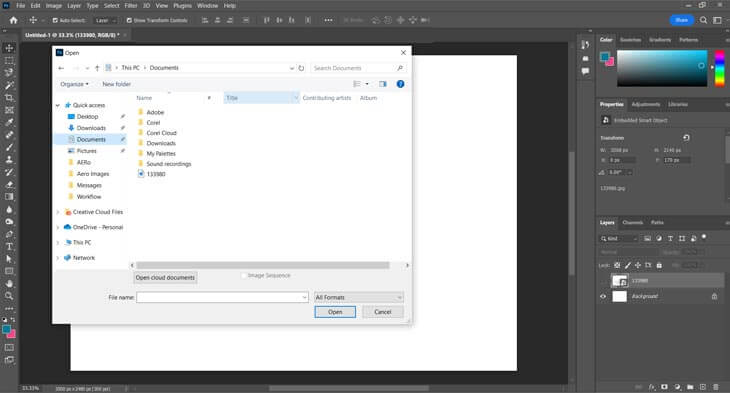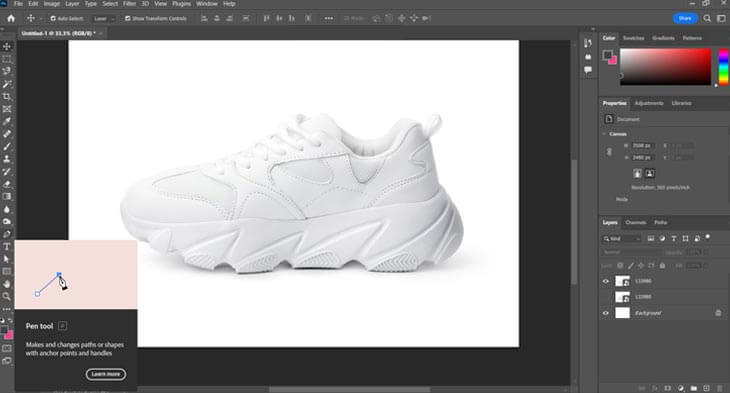What is Clipping Path? A Complete Guide & Its Applications
Clipping paths are used to isolate and create a clean, standalone image by removing unwanted elements. They are crucial for industries such as e-commerce, fashion, real estate, advertising, and more. This guide explores the definition, techniques, and best practices for clipping paths to improve visual content and attract customers.
Contents
- What is a clipping path?
- Benefits of using a clipping path in product photography
- The role of clipping paths in eCommerce
- Different types of clipping paths
- Industry applications of clipping paths
- How to create a clipping path in Photoshop
- How outsourcing clipping path services benefits businesses
Clipping paths involve drawing a closed vector path around the desired elements of an image, effectively isolating them and removing everything else. This results in a clean, standalone image that can be placed onto any new background. They are vital for e-commerce product images, advertising visuals, and graphic design projects.
Whether created manually using tools like Adobe Photoshop’s Pen Tool or outsourced to professional clipping path services, clipping paths are essential for seamlessly integrating image elements into various compositions, boosting the overall visual appeal.
In this guide, we will explore the concept of clipping paths, examining the tools, techniques, and best practices to achieve professional-level results. Whether you’re a beginner or an experienced editor, understanding clipping paths will help you enhance your image editing skills.
What is a clipping path?
A clipping path is a photo editing technique used to isolate a specific element of an image by creating a closed vector path around it, effectively removing or separating it from its background.
This technique is widely used in graphic design, photography, and e-commerce, as it allows designers to modify or eliminate backgrounds, helping the main object stand out. Software like Adobe Photoshop and Illustrator are commonly employed to create these paths, ensuring precise edits and allowing only the intended elements to remain visible.
Clipping paths are crucial for creating clean, professional visuals, especially for product photos that require a uniform background. This enhances the product’s visual appeal, making it more attractive to customers and improving the overall presentation.
What are the benefits of using a clipping path in product photography?

Role of clipping paths in eCommerce product photo editing
Clipping paths are essential tools in image editing, providing precision and control to achieve professional, high-quality results. They simplify various tasks, setting the foundation for exceptional visuals across multiple applications. Here’s how clipping paths make the process easier:
Background Removal
Clipping paths allow for the precise removal of backgrounds by creating a closed vector path around the subject, isolating it for clean and professional results in image editing.
- Illustration: This is particularly useful in product photography for e-commerce, where a consistent, white background is often needed to highlight the product.
Image Masking
Clipping paths define the exact edges of an object, which can be combined with image masking to manage intricate details and achieve smooth, refined results. They help create precise masks for complex images, ensuring only the selected areas are edited.
- Illustration: For instance, using a clipping path to isolate a shoe from a busy background, image masking can be used to refine edges and details, creating a clean, professional e-commerce product photo.
Creating Composite Images
Clipping paths isolate elements, allowing for the creation of composite images by merging objects from different photos. This technique is especially popular in advertising and creative projects, where seamless integration is crucial.
- Illustration: For example, a clipping path can be used to isolate a car from its background, and the car can be placed onto a new, scenic background to create a cohesive, professional-looking composite image.
Color Correction and Adjustment
Clipping paths allow designers to select specific areas of an image for color correction and adjustments without affecting the entire image.
- Illustration: In product catalogs, clipping paths can isolate items such as colored laces on shoes or handbags, enabling individual color enhancements for a polished and professional e-commerce photo.
Shadow Creation
Clipping paths are essential for creating realistic shadows for isolated objects, enhancing the depth and overall look of the image. This is particularly important in product photography, where shadows add a natural, three-dimensional appearance.
- Illustration: For example, isolating a watch using a clipping path and then creating a realistic shadow by duplicating, blurring, and adjusting the watch layer results in a professional e-commerce image.
Image Retouching
Clipping paths make it easier to perform detailed image retouching by isolating specific areas that need correction or enhancement.
- Illustration: In portrait photography, a clipping path can be used to isolate the subject, allowing for precise retouching such as removing blemishes and smoothing skin tones, resulting in a flawless, professional portrait.
Print Media Preparation
Clipping paths ensure that images are ready for print by isolating objects and ensuring they fit seamlessly into layouts without unwanted backgrounds. This is essential for magazines, brochures, and posters, ensuring high-quality print outputs.
- Illustration: A clipping path can isolate a company’s logo from its background, ensuring clean edges and enabling it to be placed seamlessly onto print materials like brochures and business cards.
By using clipping paths, image editors can achieve cleaner, more professional results, improving the presentation and effectiveness of visuals in various contexts.
What are the different types of clipping paths used in graphic design?
Clipping paths come in various types, each suited to different levels of complexity and applications. Here’s a breakdown of each type:
Single Layer Clipping Path
A basic clipping path that isolates a single object within an image.
- Where it is used: Ideal for simple images with clear and well-defined edges.
- How it is used: By drawing a path around the object using the pen tool in software like Adobe Photoshop or Illustrator, to cleanly remove or change the background.
- Applications and examples: Commonly used in e-commerce for product photos with simple shapes, such as books, smartphones, and boxes, to ensure they stand out against a uniform background.
Multi-Layer Clipping Path
Involves multiple layers to isolate different parts of an image separately.
- Where it is used: Used for images that contain multiple objects or have complex parts that need individual attention.
- How it is used: Separate paths are created for each object or part within the image using the pen tool, allowing for detailed edits of individual components.
- Applications and examples: Frequently used in fashion photography to separately isolate and edit clothes, accessories, and models, ensuring each element can be manipulated independently.
Complex Clipping Path
A clipping path designed for intricate and detailed images with several elements.
- Where it is used: Applied to images with many curves, holes, and fine details requiring precise outlining.
- How it is used: Carefully outlines each detailed part of the object using the pen tool to ensure precision and accuracy.
- Applications and examples: Utilized in product catalogs for items like jewelry, bicycles, and machinery, where detailed and clean visuals are necessary to highlight product features. Editing more than 324,000 images to be used in printing catalogs for a fashion retail giant impacted sales across all 47 stores owned by the company in the USA.
Compound Clipping Path
Involves multiple objects or subjects within a single image, each requiring isolation.
- Where it is used: Suitable for group images where each element needs to be edited separately.
- How it is used: Individual paths are created for each object using the pen tool, and these paths are then combined for comprehensive editing.
- Applications and examples: Used in group product photos or family portraits to isolate each person or item. It allows specific edits without affecting entire image.
Super Complex Clipping Path
Used for highly intricate and detailed images with complex shapes and transparency.
- Where it is used: Necessary for images with complex shapes, transparency, and many detailed components.
- How it is used: Advanced techniques and tools, including the pen tool, are employed to handle fine details and transparency, ensuring high accuracy.
- Applications and examples: Essential for editing images with fur, hair, or transparent objects, such as glassware and lace fabrics, to maintain the integrity of fine details and delicate elements.
Industry applications of clipping path
Clipping path services have revolutionized various industries by enhancing the quality and appeal of images. Here’s a detailed look at how different sectors benefit from this technique:

Photography and Photo Editing
In photography, particularly in portrait and fashion photography, clipping paths are essential for enhancing images. They allow photographers to remove or change backgrounds, providing a more polished and professional look for their subjects. Clipping paths also serve as a foundation for photo manipulation and artistic effects, offering a clean base for further creative work. They ensure precise cutouts for retouching and adjustments, making it easier to perfect every detail of an image.
E-commerce and Online Retail
In the competitive world of e-commerce, product images play a critical role in attracting customers. Professional photo editing, including clipping paths, significantly enhances the visual appeal of online stores. By isolating products from their backgrounds, clipping paths ensure clean, professional visuals that make each product stand out against a uniform backdrop. This technique is also used to remove and replace backgrounds in promotional materials, helping brands present their products in the best possible light, no matter the original photo setting.
Fashion and Apparel
In the fashion industry, showcasing clothing and accessories with clear, focused imagery is vital. Clipping paths allow for the isolation of garments from their backgrounds, highlighting their details and features. This technique is particularly useful for creating ghost mannequin effects, providing a professional presentation that shows how clothes fit and drape. Additionally, clipping paths support virtual fitting and mix-and-match applications for online stores, giving customers an interactive and engaging shopping experience. High-quality image processing for eCommerce catalogues can also reinforce a fashion retailer’s brand image, contributing to increased sales across multiple stores.
Jewelry and Accessories
Jewelry photography requires meticulous attention to detail, as intricate designs must be showcased clearly. Clipping paths remove background distractions, ensuring the jewelry’s craftsmanship is the focal point. This technique prepares jewelry images for online stores and catalogs, enhancing their appeal and increasing their marketability. Clipping path services help create clean, precise cutouts, ensuring that jewelry images look polished and professional across all platforms.
Real Estate
In real estate photography, clipping paths significantly improve the quality and appeal of property images. By removing distractions and highlighting key features, they help prospective buyers focus on the property itself. Clipping paths are also used in virtual staging, isolating furniture and decor elements to showcase different furnishing options within the same space. These high-quality images are ideal for brochures, listings, and promotional materials, making properties more attractive to potential buyers. For example, a real estate image editing company that processes thousands of images daily can drastically improve its brand value and turnaround time.
Advertising and Marketing
In advertising, capturing the audience’s attention requires visually compelling images. Clipping paths play a key role in creating clean and appealing ads by isolating products or models for precise placement in different contexts. This precision is essential for designing brochures, flyers, posters, and other marketing materials with flawless image cutouts. Additionally, clipping paths are used to create composite images, which allow marketers to combine various elements into a single cohesive visual, enhancing the impact of creative campaigns.
Graphic Design
Graphic designers rely on clipping paths to create intricate designs by isolating elements for collages, digital art, and other projects. This technique is crucial for preparing images for web design, app interfaces, and digital platforms, where clarity and precision are essential. Clipping paths also help in creating logos, icons, and other graphical elements, ensuring that each component is extracted cleanly and ready for use in various design projects.
Automotive Industry
In the automotive industry, clipping paths are used to highlight vehicles by isolating them from their backgrounds, ensuring that the focus remains on the vehicle’s design and features. This technique is crucial for online listings, brochures, and promotional materials, as it allows for a clear and professional representation of the vehicle. Clipping paths also enable customizations and visualizations, allowing marketers to showcase different vehicle configurations and color options, enhancing the appeal and versatility of the models.
In conclusion, clipping paths unlock endless possibilities across a wide range of industries, from photography and e-commerce to advertising and automotive, helping businesses present their products and services in a visually stunning, professional manner.
Unlock the power of clipping paths for your industry.
How do you create a clipping path in Photoshop?
Step 1: Open Image
Open the image in Adobe Photoshop.

Step 2: Select Pen Tool
Choose the Pen Tool (P) from the toolbar

Step 3: Create Path
Click to create anchor points around the object. Carefully outline the entire object.

Step 4: Close Path
Connect the last anchor point to the first to close the path.

Step 5: Create Clipping Path
In the Paths panel, select “Make Clipping Path” from the drop-down menu.

Step 6: Save File
Save your image as a .PSD or TIF file to retain the clipping path.

How does outsourcing clipping path services benefit your business?
Choosing between in-house and outsourced clipping path services involves weighing the benefits and challenges of each approach. In-house services provide direct control, allowing for immediate adjustments and ensuring consistent quality. However, this comes with higher costs and time commitments, as it requires investing in skilled personnel, training, software, and infrastructure.
Outsourcing clipping path services offers a cost-effective and flexible solution. It provides access to specialized expertise and scalability, allowing your team to focus on core activities. The main challenge with outsourcing is finding a reliable photo editing company that understands your needs and can apply the right editing techniques for your specific project.
To choose a reliable provider, conduct thorough research, review their portfolios, and seek recommendations from others. Testing their services with a small project can help evaluate their quality and turnaround time. Effective communication and clear requirements are vital to ensure the partnership aligns with your expectations and enhances your image editing capabilities.
Conclusion
Clipping path services are essential for achieving professional, high-quality visuals in industries such as e-commerce, advertising, photography, and graphic design. They provide precision and control, improving the overall appeal and professionalism of images. The decision to handle clipping paths in-house or outsource them depends on balancing factors like control versus cost-effectiveness and scalability.
To find a trustworthy outsourcing provider, research thoroughly, review their portfolios, and clearly communicate your project requirements. By leveraging clipping paths, you can significantly enhance your brand’s visual content, resulting in better engagement and success in competitive markets. Whether you choose to manage this process in-house or outsource it, clipping paths are crucial for elevating your marketing, sales, and creative efforts.


